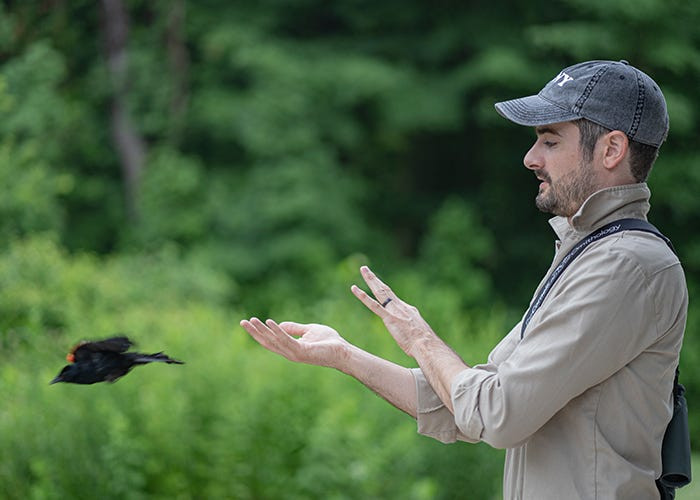USA - To expose the problem of 'predatory magazines', Professor Daniel Baldassarre at the State University of New York (USA) carried out a subtle 'prank', thereby attracting the attention of academics and the public.
In the modern academic context, a widespread problem is the existence of “predatory journals” - publications that are not intended to serve science but to exploit the lack of vigilance of researchers, especially those new to the profession, for financial gain.
Profiting 43 million VND/scientific article
On April 1, 2020, the Scientific Journal of Research and Reviews published an article titled: “What's the Deal with Birds?” In the article, Professor Baldassarre made seemingly nonsensical observations, such as: “Birds are pretty weird. I mean, they have feathers. What the hell? Most other animals don't have feathers.”

The paper also mentioned three bird species (woodpeckers, parrots and penguins) with distinct characteristics without explaining the reasons or sampling methods. This broke all standards of representativeness in research.
Furthermore, no quantitative data was collected or analyzed, and the way the observations were presented was random and illogical. The article completely failed to meet the requirements of a serious scientific study, but was a mockery of predatory journals.
The satirical highlight of the article is a chart ranking birds along an axis ranging from "weird beaks" to "fish-like."
Professor Baldassarre’s writing style adds to the irony. He mixes scientific jargon with absurdly silly remarks, such as: “This is the first study I know of that attempts to quantify the problem with birds. Unfortunately, the results are inconclusive, although Bayesian methods may be useful in the future.”
What is most astonishing is that the paper was accepted for publication without any peer review or editing process – something that goes against the standards of reputable academic journals. The fact that a satirical article, lacking scientific data and clearly intended as a joke, was able to “slip through” the editorial door shows the incredible leniency of “predatory journals”.
Initially, the journal asked Prof. Baldassarre to pay a publication fee of up to 1,700 USD (about 43 million VND). However, after a short negotiation, he was waived because the journal hoped that publishing the first article for free would encourage the author to continue to collaborate and pay for subsequent articles.
The truth behind 'predatory magazines'
Predatory journals operate by sending emails soliciting researchers to submit papers, promising quick publication but demanding very high publication fees, often in the thousands of dollars.
However, these journals ignore academic standards such as peer review. The articles published are often unreviewed, leading to the risk of publishing misleading or meaningless information.
These journals often deceive researchers by creating “slick” websites, listing prominent scientists as editors (often fake), or masquerading as reputable journals.
The existence of predatory journals not only causes financial losses but also erodes the value of scientific research.
Nonsense papers, like Prof. Baldassarre’s, have been cited. According to Google Scholar, the paper “What’s the Matter with Birds?” has been cited nine times, including one published in the Journal of Dairy Science in September 2023.
Professor Baldassarre hopes the prank will encourage researchers to double-check a journal's reputation before submitting a paper, as well as raise their vigilance against suspicious solicitation emails.
He cleverly weaves a lesson about the nature of science into the article: “That’s how science works, right? You can never have all the answers. We may never know what the problem is with birds.”
Following the publication of the paper, the academic community has opened up many discussions about the prevalence of “predatory journals” and the importance of maintaining rigorous standards of scholarly review. Some researchers, inspired by Professor Baldassarre’s approach, have taken similar actions to expose the shortcomings of these journals.
In January 2021, two researchers Martin Stervander and Danny Haelewaters published a satirical article with the title: "The 'fishy' nature of fish-like birds is related to a lack of poisonous mushrooms but not pizza") in a predatory journal.
In 2023, Professor Teresa Schultz at the University of Nevada (USA) continued to mock the Scientific Journal of Research & Reviews by publishing a research article titled: "Review of the Scientific Journal of Research & Reviews". In it, she stated: Most of the articles in this journal have a review time of only about 2 weeks and authors can pay a fee to "smooth" the review process.
This magazine is still operating openly.

Source: https://vietnamnet.vn/doc-la-nghien-cuu-choi-kham-cua-giao-su-chim-co-van-de-gi-2354545.html



![[Photo] General Secretary To Lam receives Chief of the Central Office of the Lao People's Revolutionary Party](https://vphoto.vietnam.vn/thumb/1200x675/vietnam/resource/IMAGE/2025/5/30/140435f4b39d4599a3d17975dfb444c5)

![[Photo] Journalists moved to tears at the Memorial Service for the soldiers who died in Gac Ma](https://vphoto.vietnam.vn/thumb/1200x675/vietnam/resource/IMAGE/2025/5/30/9454613a55c54c16bf8c0efa51883456)
![[Photo] A delegation of 100 journalists from the Vietnam Journalists Association visits the soldiers and people of Truong Sa island district.](https://vphoto.vietnam.vn/thumb/1200x675/vietnam/resource/IMAGE/2025/5/30/0984a986227d4e988177f560d2e1563e)
![[Photo] National Conference "100 years of Vietnamese Revolutionary Press accompanying the glorious cause of the Party and the nation"](https://vphoto.vietnam.vn/thumb/1200x675/vietnam/resource/IMAGE/2025/5/30/1cf6cd5c8a934ebfa347028dcb08358c)
![[Video] Announcing the score distribution of the 2025 HSA Competency Assessment exam](https://vphoto.vietnam.vn/thumb/402x226/vietnam/resource/IMAGE/2025/5/30/8f7b551d1e854f02a1873dcbf7f7a9ef)



















































































Comment (0)